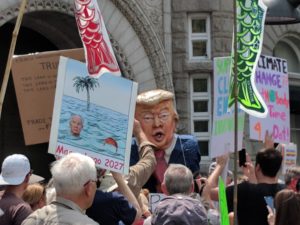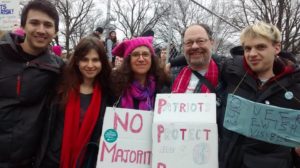40 Years Ago Today, We Changed the World (Part 4: Shifts in the Culture)
Part 4 of a series of reminiscences of the April 30/May 1, 1977 occupation at the Seabrook, NH nuclear power plant construction site, and its aftermath. If you missed Part 1, read it here, and then follow the links to Parts 2 and 3.
How Clamshell Changed the Consensus on Nuclear Safety
Remember the Three Mile Island (TMI) nuclear accident near Harrisburg, Pennsylvania, in March 1979? How about Chernobyl in the Ukraine, 1986, or Fukushima, Japan, 2011?
Of course you know about these three accidents. They received extensive news coverage at the time, and now they’re part of our history.
But unless you’re actively involved in the safe energy movement, you probably never heard of the near disasters at the Enrico Fermi breeder reactor in Michigan in 1966, or the one at Brown’s Ferry, Alabama, in 1975. These were at least as serious as TMI. In fact, there have been at least 100 potentially devastating nuclear accidents since humans began harnessing “the peaceful atom” to generate electricity.
But one important thing had changed between 1975 and 1979. By the time of TMI, nuclear power safety questions had become newsworthy. Why were they suddenly newsworthy? We can’t know the answer for certain, but I’d say the odds are very good that it was because of Clamshell and the national citizen action movement it sparked. Those efforts caused a lot more people to learn about nuclear power, and to become scared, and to take action, which inspired more people, etc.
In other words, the 1414 of us who got arrested, and the roughly 600 involved supporters who kept the lines of communication open between those of us inside and the wider world, made a difference not just in the immediate struggle but in the national consciousness. We uncorked the bottle with our questioning and our very public action, and once that bottle was uncorked, the magic spread. As a country, we learned to question the authority of nuclear utilities and of the regulators who granted them permission. We learned that the system was not protecting us. We made the issue of nuclear safety important enough to the media that they reported immediately on what was happening at TMI, Chernobyl, and Fukushima.
Even the Nuclear Regulatory Commission admits this. Tom Wellock, a historian there, told the Boston Globe,
What happened with the Clamshell Alliance at Seabrook is that it really nationalized consciousness about nuclear power and inspired similar groups around the country. Their influence on policy-makers certainly mattered.
Rebecca Solnit notes, “Sixty-six nuclear power plants were cancelled in the wake of Clamshell.”
And Harvey Wasserman, one of the safe energy movement’s early activists and chroniclers, noted in 2007 that the protests led to an important secondary impact:
Inspired in part by the protests, Jane Fonda and Michael Douglas’s China Syndrome, happened to open in theaters just as TMI went to the brink. The industry took the double body blow of a terrifying disaster and a Hollywood blockbuster.
What Clamshell Changed About Later Activism (Occupy, DT resistance, Sugar Shack Alliance, etc.)
Organizationally, Clamshell Alliance provided many lessons to later social change struggles. Nonviolent resistance in the US—the iconic strategy of the Civil Rights movement—had been fairly dormant since the US military pulled out of Vietnam in 1975. Clam revived it, and our spiritual younger siblings around the country like the Abalone Alliance in California and the Sunflower Alliance in Kansas spread it far and wide.
Interestingly, a group of disillusioned protestors, impatient with the slowness of nonviolent struggle, formed the Coalition for Direct Action at Seabrook in 1979—a group willing to use property destruction and to physically battle with law enforcement. CDAS’s actions were failures, serving mostly to discredit the protestors in the eyes of some locals—a failure that would be repeated in “The Battle in Seattle,” a protest against the World Trade Organization in 1999 where the small number of violent protestors dominated the media coverage and alienated many people.
Later struggles, such as Tiananmen Square and Arab Spring, returned to committed, principled nonviolence. This was also much in evidence in the South African struggle against its apartheid government in the 1980s (though not all elements were nonviolent).
Many movements in this current decade of the 2010s built directly on Clamshell’s process and tactics: Occupy, the stop-fossil-fuel-pipelines struggle (including Standing Rock), and the intersectional movement of resistance against the Trump administration.
Occupy’s ultra-democratic process no-leader, with innovations such as using a human chorus as a microphone to repeat a statement so others could hear, would probably never have evolved if it weren’t for the process innovations of Clam.
From that article by Rebecca Solnit linked above:
Their spirit and their creative new approach inspired activists around the country and helped generate a movement…Clamshell Alliance and many of the antinuclear groups that followed developed non-hierarchical, direct-democracy methods of organizing since used by activists and movements throughout the U.S. and beyond, including Occupy Wall Street, whose consensus-based general assemblies owed a lot to a bunch of hippies no one remembers.
Pipeline opponents took many leaves from Clamshell’s playbook, including naming their resistance groups. For example, the name of the Sugar Shack Alliance near me, contesting pipelines across Massachusetts, Connecticut, and New Hampshire, reminds us that gas and oil pipelines threaten the maple sugaring industry—as does the severe climate change that fossil fuel infrastructure enables. Members pledge to train in nonviolent resistance and its code of conduct (click Nonviolence Training on the group’s home page) is almost identical to Clamshell’s 40 years earlier. In fact, just this week, 18 people were arrested at a Sugar Shack Alliance sit-in to protect trees in Otis (MA) State Forest that the pipeline company had gotten federal permission to cut down (in violation of state law). Meanwhile, in North Dakota, Water Protectors at Standing Rock opposed to a different pipeline waged a months-long occupation combining Native American spirituality and deep nonviolence in the face of serious repression.
And the post-election resistance understands the power of multiple sustained actions and on addressing multiple issues and constituencies while focusing on a more targeted immediate goal. It’s exciting to see these movements (and to participate in some).
Activists for a Lifetime
Clam not only changed the landscape in terms of resistance to nuclear power, but also changed the lives of many (perhaps all) who were involved. Over the years, I’ve constantly discovered that many people who were doing some of the best organizing work in sector after sector turn out to be Clamshell alumni. And as I prepare to attend a Clamshell reunion this weekend, I look at the list of attenders (and their email signatures) and I see that lots of them are still deeply involved in social change (as I am). I was one of the younger Clams, so many of these folks are well into their 60s and beyond.
My own life was impacted in lots of ways. One of those was my decision to live in an intentional community populated heavily with Clam veterans steeped in nonviolence theory and practice—the group that had developed the small-to-large consensus process, in fact. I lived at the Philadelphia Life Center in 1980-81, and learned much about meeting process, social change theory, and how personal growth can integrate with organizing.
A second was Save the Mountain, the movement I founded in 1999 (and devoted more than a year of volunteer time to) that saved our local mountain. I used many tools I’d learned at Seabrook and in that later nonviolent activist community.

More recently, starting in 2013, I’ve focused my career on combining both marketing and community organizing to achieve social change and environmental justice: leveraging the business community to turn hunger and poverty into sufficiency, war into peace, and catastrophic climate change into planetary balance—not through guilt and shame, but harnessing enlightened self-interest. Among other things, this involves helping businesses develop and market profitable products and services that directly address these goals.
Nuclear’s Deep Sleep (only 1/10 of Nixon’s goal)
The final impact I want to discuss (there were others) was the end of the industry’s dream. Richard Nixon called for 1000 nuclear plants in the US; it topped out at 112 and is now at 99 or 100. And nuclear power plant construction ground to a nearly complete halt for decades. After 1996, the next new commercial reactor in the US only went online in 2016. Four are under construction in Georgia and South Carolina, but these have been plagued by cost overruns, delays, manufacturing issues, and horrible economics including a bankruptcy by the reactor designer, Westinghouse, directly related to these projects; experts predict that they will never go online. Meanwhile, several plants including Vermont Yankee won a license extension from the NRC only to close just a few years later.
This series will wrap up with Part 5, on the current state of nuclear power and how the safe energy movement can organize to block a “zombie nuclear return from the dead.” Stay tuned!








